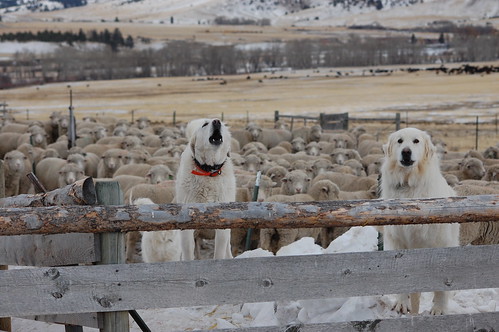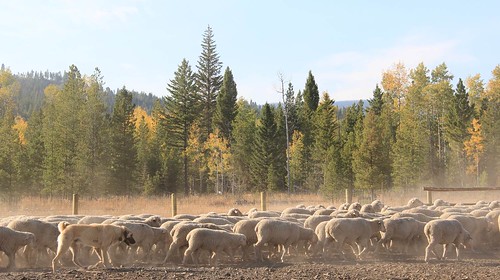By Travis Kocurek

USDA’s Animal and Plant Health Inspection Service is helping to provide livestock producers in the western United States with livestock guard dogs that offer greater protection against predators.
Generally large and white with shaggy hair, livestock protection dogs are trained to respond aggressively to predators such as wolves, bears, and coyotes. Guard dogs are often used in the sheep industry as a method of non-lethal predator management because of their perceived effectiveness and low cost to producers. According to a 2010 American Sheep Industry survey, guard dog use is only second to shed lambing at effectively reducing depredation. Shed lambing, that is, raising lambs exclusively indoors, however is more than 9 times the annual cost of using a dog for lamb protection. Owing to the low cost of using livestock protection dogs, they are extremely valuable to the sheep industry. According to Michael Marlow, resource management specialist for APHIS’ Wildlife Services program, many producers are certain they’d be out of business without them.
Julie Hansmire, who has used and bred livestock protection dogs for several years, agrees. “Without the help of these protection dogs, sheep producers would find it extremely challenging to protect their flocks 24 hours a day,” she adds.
Because the dogs live permanently with the sheep, they also give producers the peace of mind to temporarily focus their attention elsewhere. This level of comfort owes to the fact that the dogs are very good at what they are trained to do. In fact, according to the same 2010 American Sheep Industry survey, 90% of survey respondents who utilize guard dogs reported an average decrease of 62% in sheep depredation after starting to use them.
Despite these positive figures, producers have noticed that in areas where pressures from larger predators such as grizzly bears and wolves have increased, traditional dog breeds may not be able to meet the challenge. Dr. Julie Young at APHIS’ Predator Research Facility in Logan, UT, is researching the efficacy of using larger European dog breeds to protect sheep against these larger predators. Although more data is needed, some of the larger breeds used in this study may prove to be an effective alternative to the livestock protection dog breeds used more commonly today.
- See more at: http://blogs.usda.gov/2015/05/19/dogs-help-protect-livestock-against-predators/#sthash.FEmK9kVr.dpuf
Working dogs like these two livestock protection dogs help drive off predators such as wolves, bears, and coyotes, and offer sheep ranchers an alternative to reducing livestock losses.
USDA’s Animal and Plant Health Inspection Service is helping to provide livestock producers in the western United States with livestock guard dogs that offer greater protection against predators.
Generally large and white with shaggy hair, livestock protection dogs are trained to respond aggressively to predators such as wolves, bears, and coyotes. Guard dogs are often used in the sheep industry as a method of non-lethal predator management because of their perceived effectiveness and low cost to producers.
According to a 2010 American Sheep Industry survey, guard dog use is only second to shed lambing at effectively reducing depredation. Shed lambing, that is, raising lambs exclusively indoors, however is more than 9 times the annual cost of using a dog for lamb protection. Owing to the low cost of using livestock protection dogs, they are extremely valuable to the sheep industry. According to Michael Marlow, resource management specialist for APHIS’ Wildlife Services program, many producers are certain they’d be out of business without them.
Julie Hansmire, who has used and bred livestock protection dogs for several years, agrees. “Without the help of these protection dogs, sheep producers would find it extremely challenging to protect their flocks 24 hours a day,” she adds.
Because the dogs live permanently with the sheep, they also give producers the peace of mind to temporarily focus their attention elsewhere. This level of comfort owes to the fact that the dogs are very good at what they are trained to do. In fact, according to the same 2010 American Sheep Industry survey, 90% of survey respondents who utilize guard dogs reported an average decrease of 62% in sheep depredation after starting to use them.
Despite these positive figures, producers have noticed that in areas where pressures from larger predators such as grizzly bears and wolves have increased, traditional dog breeds may not be able to meet the challenge. Dr. Julie Young at APHIS’ Predator Research Facility in Logan, UT, is researching the efficacy of using larger European dog breeds to protect sheep against these larger predators. Although more data is needed, some of the larger breeds used in this study may prove to be an effective alternative to the livestock protection dog breeds used more commonly today.

Can you spot the dog at work? Because they live with the flocks, these working dogs are always on the job watching over their flocks
Source:USDA